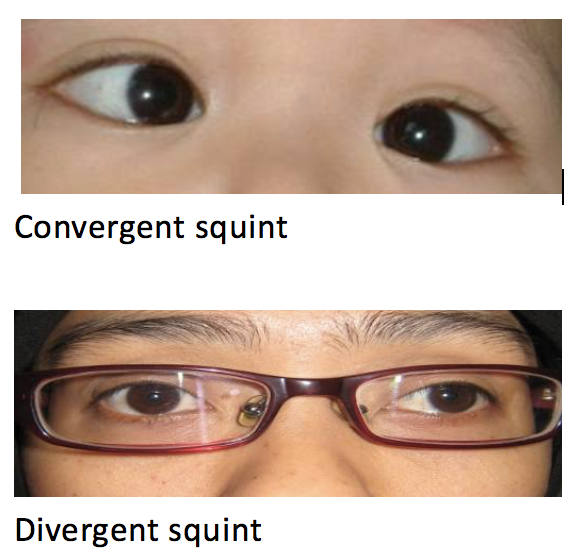Children can be born with squint or develop it in childhood.
It can be constant or intermittent, occurring when the child is tired or daydreaming. It can also be alternating, sometimes seen on the right and sometimes on the left eye.
When the eyes are straight, images formed in each eye are sent to the brain and it is fused into a single, three dimensional (3D) image which gives us depth perception. When a child has a squint, two different images are sent to the brain. The brain learns to ignore the image seen by the misaligned eye and after some time the image is being suppressed.
This condition is called amblyopia or lazy eye. Adults who are recently diagnosed with a strabismus often complain of double vision (diplopia) because the brain is unable to ignore the different images.

In general, most children do not complain of eye problems or notice changes in their vision. Common signs and symptoms seen are: closing one eye to see
There are many types of squints but the two most common forms are below.
Accommodative Esotropia often occurs because of uncorrected refractive error. When a child has uncorrected far- sighted/ hypermetropia, one will tend to accommodate to focus. People who are far-sighted have to focus extra hard to keep images clear.
This may cause the eyes to turn inward. It usually occurs at age 1 to 3 years old. Glasses are usually prescribed to improve the focusing ability, enabling the eyes to straighten.
After glasses correction, Fully accommodative squint can be totally corrected just with glasses whereas in some cases which are Partially accommodative squint a child needs muscle alignment surgery for significant residual squint.
Intermittent exotropia occurs when one eye drifts outwards occasionally. It usually manifest during illness, fatigue and more often when viewing at a distance. Treatment varies. In some, non-medical treatment like spectacles, eye patching or eye exercises are appropriate; while in others, eye muscle surgery is necessary.
A squint can be diagnosed during a full eye examination. If you suspect that your child has a squint or if there is a family history of squint or amblyopia, it is advisable that you bring your child for a complete eye exam by an ophthalmologist to find out the cause because in some patient a life threatening cancer or permanent scar in the eye can be the underlying reason why the child is not focusing well.
Once the diagnosis is established, the treatment plan can be discussed to help your child accordingly.